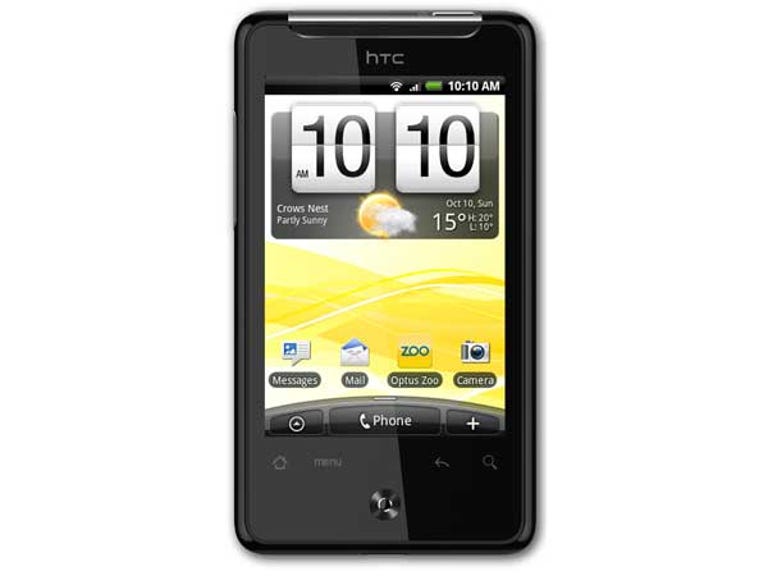 Why You Can Trust CNET
Why You Can Trust CNET HTC Aria review: HTC Aria
The Aria is a solid Android smartphone featuring some very attractive design, but it's a bit expensive compared with other, better-featured phones.
Design
The Aria draws an interesting line between HTC's top-shelf phones, like the Desire and its first attempt at a budget Android, Wildfire. Aria is neither top-shelf nor budget, existing instead in that nebulous space between. For this reason, the Aria needs the right mix of trade-offs and inclusions, and to this end HTC has opted for a premium quality construction, but a lower resolution display in a smaller package all-round.
The Good
The Bad
The Bottom Line
The display in question is a 3.2-inch HVGA resolution LCD screen, no AMOLED or Super LDC tech in play here. The results are a clearly duller display than you'll find on the HTC Desire or Legend, but still a very usable screen for both viewing information and for input via its capacitive touchscreen technology. This smaller screen does, of course, mean the Aria's virtual keyboard is also smaller, which does make typing tricky for those with chunky digits.
All other input is handled by a capacitive touch panel below the screen and an optical mouse to make selections. It might just be a matter of preference, but we far prefer the mechanical buttons on the Desire and HD2. Capacitive buttons tend to "press themselves", which is especially annoying when it takes you back a page in the web browser or back to the home screen in the middle of typing up a longer email. We also dislike the position of the screen-lock key, which is placed on the top right of the phone, which means you'll have to contort your hand uncomfortably each time you want to turn the phone back on.
As with all recent HTC phones, the Aria charges via a micro-USB port on the base of the handset, with a 3.5mm headphone socket on the top and a microSD card slot for expanding the internal memory, which is safely secured below the battery cover.
Features
So what do you get besides the Android 2.1 operating system? You get the same suite of HTC Sense software that you would get if you bought a Desire. This includes the built-in Facebook and Twitter integration and the Friend Stream home screen social-networking widget. The address book has HTC's ubiquitous Sense makeover and is capable of linking contacts already saved in your address book with the friends you have on Facebook. You also get the same range of customisation you'd get on any Android phone, though like the Legend, HTC has stripped Live Wallpapers out of the Aria, probably due to the lower powered processor.
If you haven't come across the HTC Sense UI, you're in for a treat. Basically, Sense is the name HTC gives to all the added extras it adds to make Android more user-friendly. When you turn the Aria on you'll see Sense straight away; a seven-panel home screen to which you can add and subtract any of the widgets HTC preloads. Some of these widgets include the sexy clock/weather tool that is the first thing you see when you use the phone. If you click on the address book or go into the Messages app you'll see evidence of Sense again, with its tabbed app menus at the bottom of the screen.
But Sense isn't just about home screen widgets and wallpapers, there's also built-in Facebook integration, a neat Twitter app called "Peep", a heavily-customised music app, and HTC's geotagging photo gallery called "Footprints".
Shutterbugs will appreciate Aria's 5-megapixel camera, but will notice the lack of a flash immediately. The software works as we've seen from HTC before, with a software auto-focus included among other key settings like white balance presets and image quality. Right next to the camera sensor you'll find a surprisingly loud external speaker covered by quite a stylish-looking stainless-steel grille.
Performance
If you've scanned through the spec sheet for Aria and spotted its 600MHz processor, you probably assume it is about half as powerful as the 1GHz processor in Desire. Smartphone performance is a tough thing to quantify, but during our tests we saw mostly excellent performance. Benchmarking tests we ran revealed slower performance than the Desire, but in day-to-day use you'd be hard pressed to spot it. You notice some processing hiccups when opening data-heavy apps, like your address book with its several hundred entries, but most menu-scrolling and home-screen navigation works as intended.
The pint-sized Aria packs an impressive 1200mAh battery pack under the screw-locked battery cover, and with it it manages to get through the better part of two days of moderate use.
Overall
It terms of build quality, features and performance, the Aria is in line with the other excellent Android phones in HTC's 2010 range. We love the sturdy plastic chassis with the exposed industrial elements, the screws and the stainless steel grille, and our only real disappointment is the lower quality display compared with the Desire and HTC Legend.
However, we're not convinced this device offers the best value for money. At AU$49 per month, and only available on the Optus network, the Aria will set you back the same as the higher spec Desire on the Next G network (a phone that features a larger, higher-resolution AMOLED display and a 1GHz processor) and the Samsung Galaxy S, also on the Optus network. There really is little point offering a mid-range alternative when it costs as much as the best HTC has to offer.


